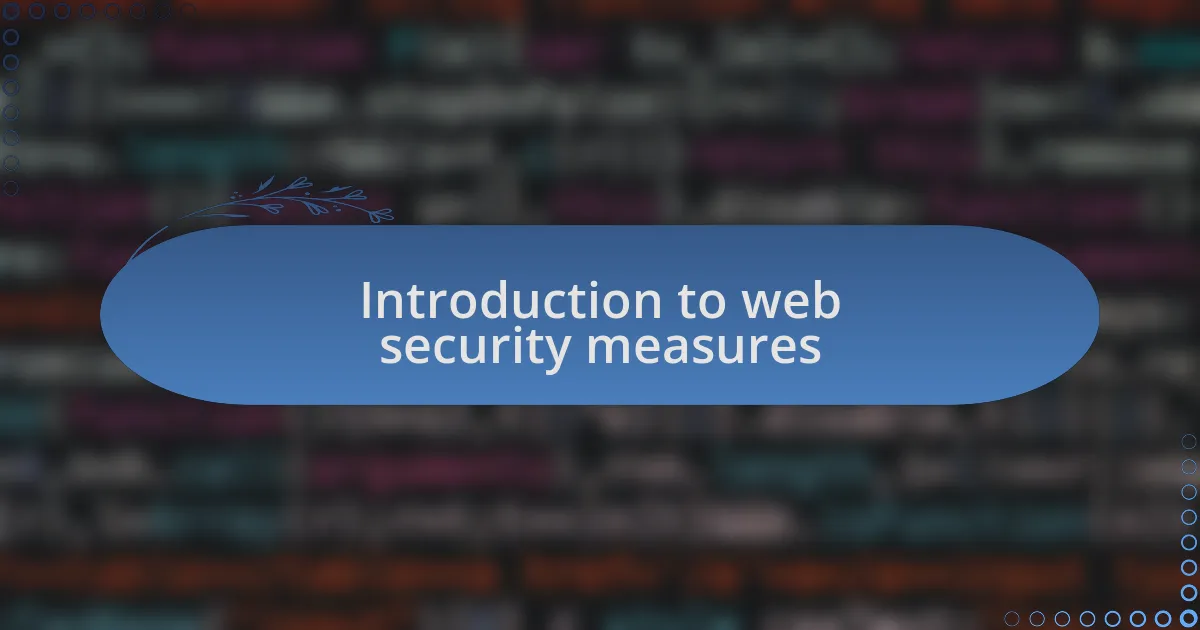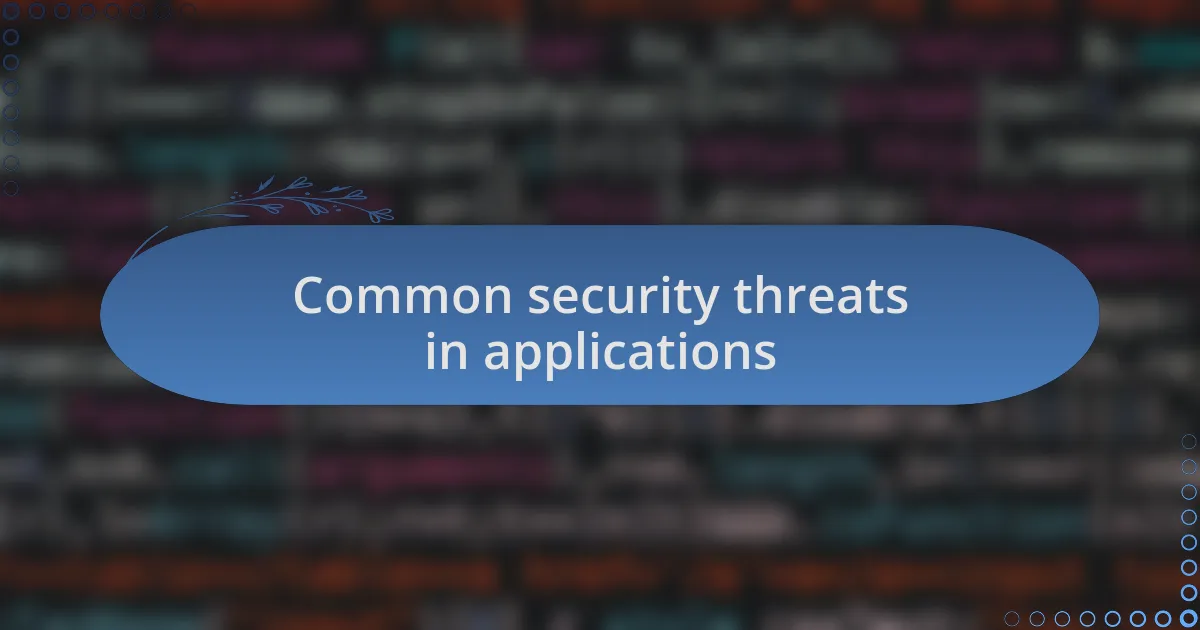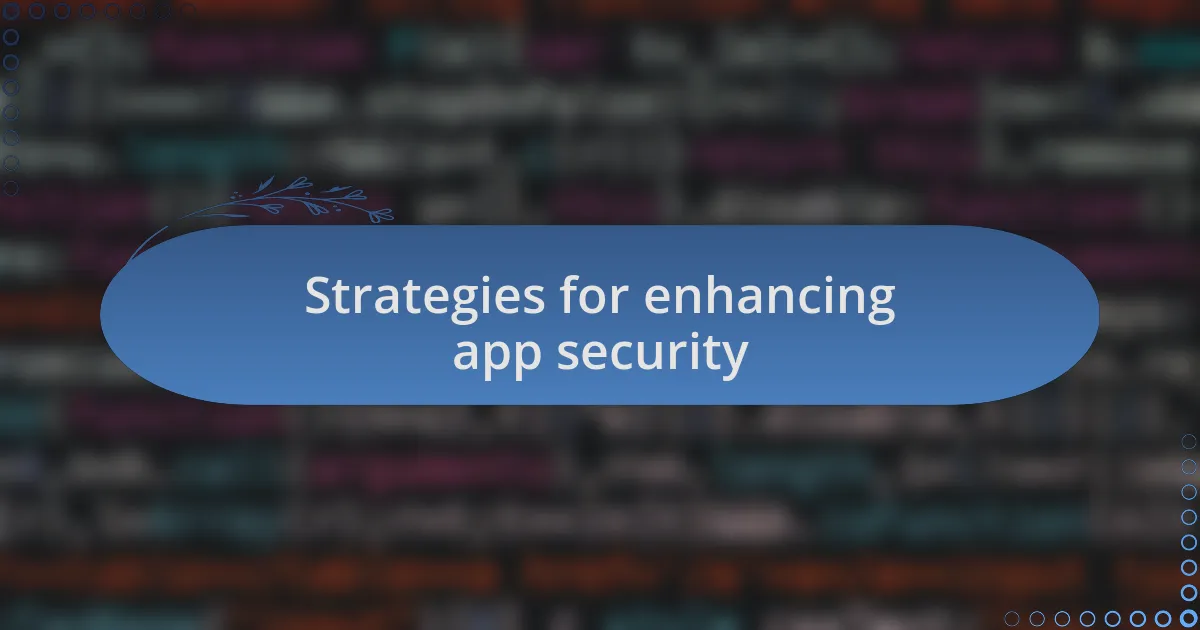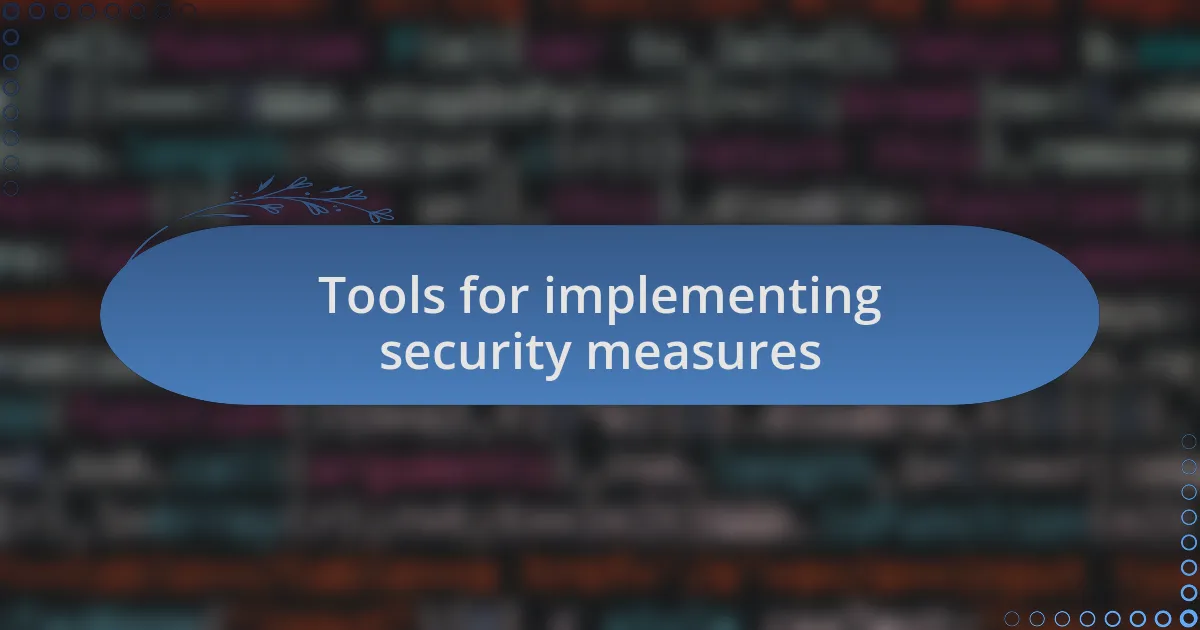Key takeaways:
- Security measures are essential in app development, requiring continuous learning and adaptation to protect user information.
- Common threats include SQL injection, weak passwords, and cross-site scripting (XSS), emphasizing the need for proper validation and input sanitization.
- Effective strategies for enhancing security involve multi-factor authentication, regular security audits, and keeping software dependencies up to date.
- User education is crucial, as it empowers users and reduces security incidents; ongoing collaboration with other developers fosters stronger security practices.

Introduction to web security measures
When I first ventured into app development, I quickly realized that security measures are not just optional but essential. I remember launching one of my early apps, feeling proud of its design, only to be met with security issues that nearly derailed the project. It made me question, how can we protect our creations in an increasingly digital world?
Understanding web security measures feels a lot like learning to ride a bike; at first, it can be daunting, but once you grasp the basics, it empowers you to go further. Simple steps like implementing HTTPS or regularly updating software can feel almost routine, but they offer robust protection against vulnerabilities. Have you ever considered how every minor oversight can lead to potential breaches?
Delving into web security means looking beyond just the tech itself. It’s about fostering trust with users, knowing that when they use your app, their information is safeguarded. I’ve come to learn that securing an app is an ongoing commitment; it demands continuous learning and adaptation to emerging threats. Why do we work so hard to build something if we aren’t equally invested in its protection?

Common security threats in applications
Security threats in applications can take many forms, and each one poses significant risks. One instance that I remember vividly involved a SQL injection attack on a project I worked on. It was shocking to see how easily an attacker exploited a vulnerability in our database. That incident underscored how crucial it is to validate user input and sanitize data effectively.
Another common threat is the use of weak passwords. Reflecting back on my early days of app development, I recall the time when I underestimated the importance of enforcing strong password policies. It’s alarming how many users gravitate towards simple, easy-to-remember passwords. Have you ever thought about the implications of a single weak password on broader security?
Then there’s the threat of cross-site scripting (XSS). I still feel a sense of urgency when I think about a client app I developed that faced this risk. Attackers can inject malicious scripts into web pages viewed by other users, leading to data theft or session hijacking. Encountering such vulnerabilities made me acutely aware of the importance of escaping user inputs to safeguard an application’s integrity.

Strategies for enhancing app security
When it comes to enhancing app security, one strategy I found effective was implementing multi-factor authentication (MFA). I remember when I integrated this feature into one of my own applications; it was like adding an extra lock to a door. The peace of mind that came with knowing users had to verify their identity through another method was invaluable. Have you ever thought about how much stronger your security could be with just a little extra verification?
Another approach I embraced was regular security audits and vulnerability assessments. It was eye-opening to conduct these checks periodically; I often discovered issues I had overlooked during development. There was a time I ran an audit and found a forgotten endpoint that was completely open. This experience taught me that ongoing vigilance is crucial—the landscape of threats is always changing, and what was secure yesterday might not be today.
Lastly, I can’t stress enough the importance of keeping software dependencies up to date. I learned this lesson the hard way when an outdated library led to vulnerabilities I couldn’t believe I’d missed. The moment I started prioritizing regular updates, I noticed a tangible decrease in security incidents. In your own development journey, how often do you check for updates? It’s a small step but can lead to significant improvements in the overall security of your application.

Tools for implementing security measures
When it comes to tools for implementing security measures, I’ve found that using encryption libraries is a game changer. In one of my projects, integrating a library for data encryption not only protected user information but also added a level of trust between me and my users. Can you imagine how it feels to know that sensitive data is locked away, like a digital safe?
Another essential tool I often use is intrusion detection systems (IDS). There was an instance when an IDS alerted me to a suspicious login attempt before any damage could be done. Real-time alerting is like having a security guard on your app’s digital perimeter, constantly watching for threats. Have you considered how much peace of mind comes from knowing potential attacks can be caught before they escalate?
Finally, I can’t overlook the importance of using secure coding standards. While I was learning to code, I stumbled upon the OWASP Top Ten—a list of the most critical web application security risks. Adopting these standards helped me avoid common pitfalls, like SQL injection vulnerabilities, that could have compromised my applications. How often do you assess your coding practices against established guidelines? It’s a straightforward way to bolster your app’s defenses without reinventing the wheel.

Lessons learned from security enhancements
When I pushed forward with implementing enhanced security measures, one lesson stood out: the importance of user education. During a project, I frequently shared information on best security practices with my users, which not only empowered them but also reduced the number of security incidents. It made me realize that even the best technology cannot compensate for a lack of awareness—how often do we assume users know how to protect themselves online?
Additionally, I learned the hard way that no security system is foolproof. Early on, I faced a breach that exploited a small vulnerability I had overlooked. The experience taught me that security is an ongoing process; I now conduct regular audits and updates, treating them like routine maintenance. This proactive approach has turned what once felt like a post-incident reaction into an essential part of my development cycle.
Finally, I came to appreciate the value of collaboration in the realm of security. Joining discussions with fellow developers revealed new perspectives on threats I had never considered before. For instance, a simple brainstorming session about recent security trends introduced me to advanced threat modeling techniques that I now implement regularly. Have you ever considered how sharing knowledge can foster stronger security practices across the board? It’s a mindset shift that not only benefits our own applications, but could potentially protect an entire community of users.